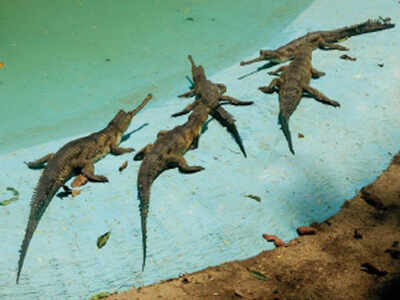
KANPUR: Over 30 ghariyal hatchlings at Yamuna ghat in Etawah have once again broken the myth of environmentalists, who are amazed to witness the aquatic animal preferring to breed for the second time in Yamuna, which is considered to be the highly polluted river of the country.
According to environmentalists, ghariyal (Gavialis gangeticus), is a native to sandy freshwater river banks, and that sightings of such a huge number of hatchlings only indicates that Yamuna now no more remains a polluted river, atleast in Etawah.
Rajiv Chauhan, conservation officer, Wildlife Institute of India (WII), Dehradun, said, "Sighting of hatchlings not only shows that the population of ghariyal is increasing in the region, but it also indicates that water of Yamuna is no more polluted as the reptile, which is considered critically endangered by the International Union for Conservation of Nature, only breeds in fresh water". It is listed in Schedule-I of the Wildlife Protection Act, 1972, which includes animals such as rhinoceroses, elephants, lions, tigers and snakes, he said.
As usual, Chambal river accounts for majority of the ghariyal population in the country. Just 200-300 ghariyals are believed to be left in Chambal and Katarniaghat in Bahraich, besides 2,000 to 3,000 across India.
The mating season of ghariyal begins from November and goes till December and January. The nesting and laying of eggs takes place in March, April and May. During the dry season, the rivers shrink a bit and the sandy river banks are available for nesting. Around 40 and 60 eggs are deposited into the sand pits that the female digs up before it is covered over carefully, and after about 90-100 days, the little ones crawl out.
"More than 30 hatchlings were noticed about a week ago in the sand beds of Yamuna and this happened for the second time. Earlier, ghariyal hatchlings were sighted in Yamuna in Etawah in 2011," informed Sanjiv Chauhan, secretary, Society for Conservation of Nature.
"For the second time, such hatchlings have been recorded in Yamuna in Etawah. It is a positive indication," said Satyapal Singh, divisional forest officer, social forestry division.
According to environmentalists, ghariyal (Gavialis gangeticus), is a native to sandy freshwater river banks, and that sightings of such a huge number of hatchlings only indicates that Yamuna now no more remains a polluted river, atleast in Etawah.
Rajiv Chauhan, conservation officer, Wildlife Institute of India (WII), Dehradun, said, "Sighting of hatchlings not only shows that the population of ghariyal is increasing in the region, but it also indicates that water of Yamuna is no more polluted as the reptile, which is considered critically endangered by the International Union for Conservation of Nature, only breeds in fresh water". It is listed in Schedule-I of the Wildlife Protection Act, 1972, which includes animals such as rhinoceroses, elephants, lions, tigers and snakes, he said.
As usual, Chambal river accounts for majority of the ghariyal population in the country. Just 200-300 ghariyals are believed to be left in Chambal and Katarniaghat in Bahraich, besides 2,000 to 3,000 across India.
The mating season of ghariyal begins from November and goes till December and January. The nesting and laying of eggs takes place in March, April and May. During the dry season, the rivers shrink a bit and the sandy river banks are available for nesting. Around 40 and 60 eggs are deposited into the sand pits that the female digs up before it is covered over carefully, and after about 90-100 days, the little ones crawl out.
"More than 30 hatchlings were noticed about a week ago in the sand beds of Yamuna and this happened for the second time. Earlier, ghariyal hatchlings were sighted in Yamuna in Etawah in 2011," informed Sanjiv Chauhan, secretary, Society for Conservation of Nature.
"For the second time, such hatchlings have been recorded in Yamuna in Etawah. It is a positive indication," said Satyapal Singh, divisional forest officer, social forestry division.
World Cup 2019
Trending Topics
LATEST VIDEOS
More from TOI
Navbharat Times
Featured Today in Travel
Quick Links
Lok Sabha Election Schedule 2019Lok Sabha Election NewsDelhi Capitals teamMI team 2019Rajasthan Royals 2019RCB team 2019Maharashtra Lok Sabha ConstituenciesBJP Candidate ListBJP List 2019 TamilnaduShiv Sena List 2019AP BJP List 2019Mamata BanerjeeBJP List 2019 MaharashtraPriyanka GandhiBJP List 2019 KarnatakaAMMK Candidate List 2019BJP List 2019 WBLok Sabha Elections in Tamil NaduBSP List 2019 UPNews in TamilLok Sabha Poll 2019Satta Matka 2018PM ModiMahagathbandhanNagpur BJP Candidate ListChandrababu NaiduTamil Nadu ElectionsUrmila MatondkarNews in TeluguMadras High CourtTejashwi YadavArvind KejriwalTejasvi SuryaPawan KalyanArvind KejriwalYogi AdityanathJaya PradaSatta King 2019Srinagar encounter
Get the app







